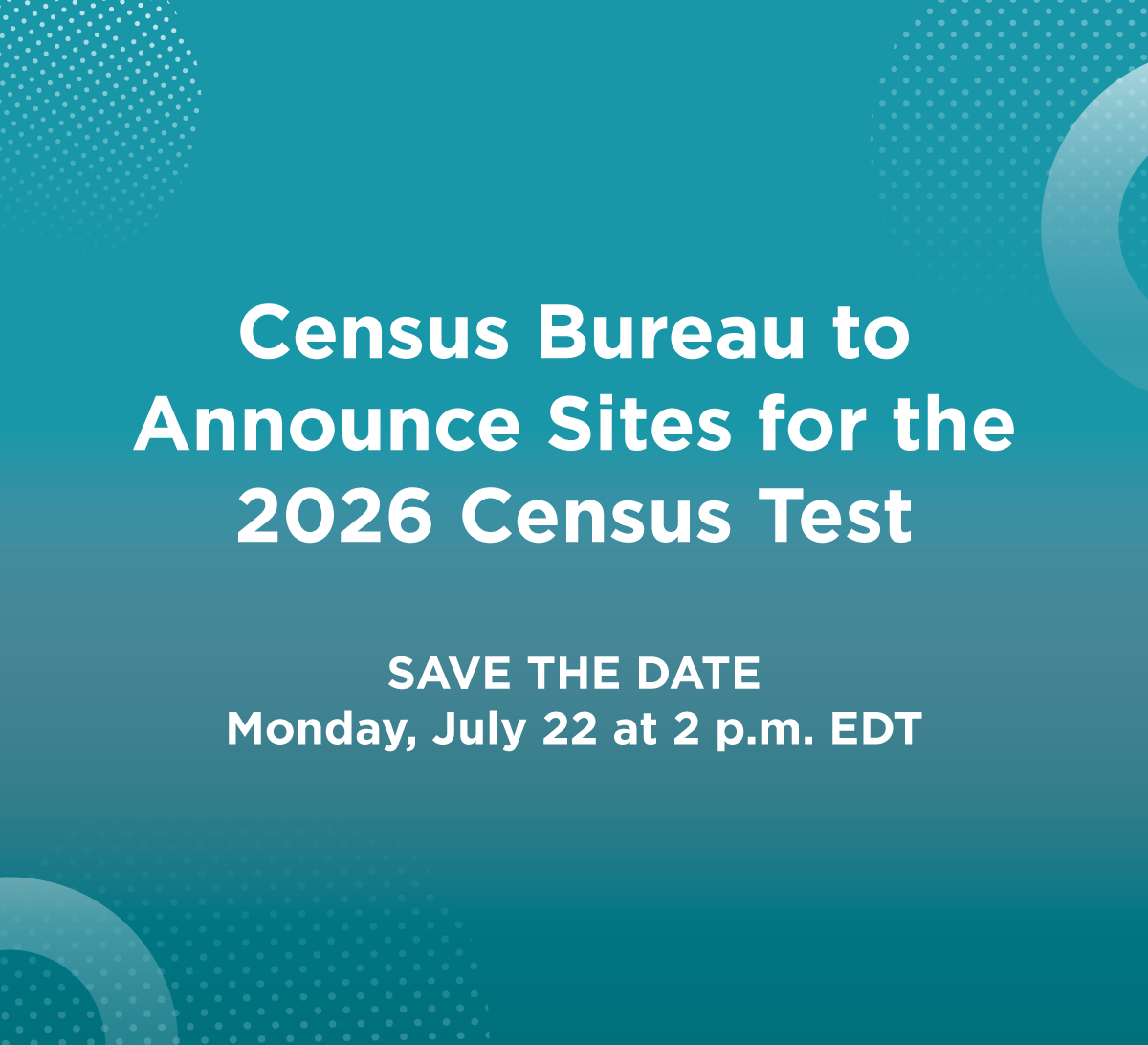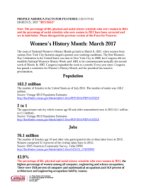Women's History Month: March 2017
*Revised: Friday, March 17, 2017*
Note: The percentage of life, physical and social science scientists who were women in 2015 and the percentage of social scientists who were women in 2012 have been corrected and are in bold below. Please disregard the previous version of this Facts for Features.
The roots of National Women’s History Month go back to March 8, 1857, when women from various New York City factories staged a protest over working conditions. The first Women's Day Celebration in the United States was also in New York City in 1909, but Congress did not establish National Women's History Week until 1981 to be commemorated annually the second week of March. In 1987, Congress expanded the week to a month. Every year since, Congress has passed a resolution for Women’s History Month, and the president has issued a proclamation.
Population
163.2 million
The number of females in the United States as of July 2015. The number of males was 158.2 million.
Source:
Vintage 2015 Population Estimates
2 to 1
The approximate ratio by which women age 85 and older outnumbered men in 2015 (4.1 million to 2.1 million).
Source:
Vintage 2015 Population Estimates
Jobs
76.1 million
The number of females age 16 and older who participated in the civilian labor force in 2015. Women comprised 47.4 percent of the civilian labor force in 2015.
Source:
2015 American Community Survey, Table DP03
43.9%
The percentage of life, physical and social science scientists who were women in 2015, the highest percentage of women among all computer, engineering and science occupations. There were 24.8 percent of computer and mathematical occupations and 14.0 percent of architecture and engineering occupations held by women.
Source:
2015 American Community Survey, Table S2402, Occupation by Sex
Table B24020, Sex by Occupation for the U.S.
63.0%
Percentage of social scientists who were women, the heaviest representation of women among all STEM (science, technology, engineering and math) fields. Among other STEM fields, approximately 14 percent of engineers, 45 percent of mathematicians and statisticians, and 47 percent of life scientists were women. The rates of mathematicians and statisticians, and life scientists are not statistically different from each other.
Source:
2012 American Community Survey and Sex, Race, and Hispanic Origin by Occupation: 2012, Table 2
Percentage of Women in Select Occupations
| 1970 | 2006-2010 | |
|---|---|---|
| Registered nurses | 97.3 | 91.2 |
| Dental assistants | 97.9 | 96.3 |
| Cashiers | 84.2 | 74.7 |
| Pharmacists | 12.1 | 52.6 |
| Accountants | 24.6 | 60.0 |
| Computer programmers | 24.2 | 24.4 |
| Physicians and surgeons | 9.7 | 32.4 |
| Lawyers and judges | 4.9 | 33.4 |
| Police officers | 3.7 | 14.8 |
| Civil engineers | 1.3 | 12.7 |
Source: 1980 and 1970 Census of Population Supplementary Reports - Detailed Occupation of the Experienced Civilian Labor Force by Sex for the United States and Regions, and EEO Tabulation EEO-ALL1R based on 2006-2010 American Community Survey
14.2%
The percentage of employed women age 16 and older in 2015 who worked in management, business and financial occupations, compared with 15.8 percent of employed men in the same year.
Source:
2015 American Community Survey, Table B24010
Military
1.6 million
The number of women veterans in the United States in 2015.
Source:
2015 American Community Survey, Table B21001
Earnings
9.7%
The percentage of married couples in 2016 where the wife earned at least $30,000 more than the husband.
Source:
Families and Living Arrangements, 2016, Table FG3
$40,742
The median annual earnings of women age 15 and older who worked full time, year-round in 2015. In comparison, the median annual earnings of men were $51,212.
Source:
$0.80
The amount that full-time, year-round female workers earned in 2015 for every dollar their male counterparts earned.
Source:
Education
12.5 million
The number of women enrolled in undergraduate college and graduate school in 2015. Women comprised 55.4 percent of all college students (undergraduate and graduate).
Source:
American Community Survey, 2015, Table B14002
30.9%
The percentage of women age 25 and older who had obtained a bachelor’s degree or more as of 2015. The percentage of men age 25 and older who had obtained a bachelor's degree or more as of 2015 was 30.3 percent.
Source:
American Community Survey, 2015, Table S1501
Business
$1.4 trillion
The estimated receipts from women-owned firms in the United States in 2012, rising 18.7 percent from $1.2 trillion in 2007.
Source:
2012 Survey of Business Owners, Statistics for All U.S. Firms by Industry, Gender, Ethnicity, and Race
9.9 million
The estimated number of women-owned firms in the United States in 2012, up from 7.8 million or 26.8 percent in 2007.
Source:
2012 Survey of Business Owners, Statistics for All U.S. Firms by Industry, Gender, Ethnicity, and Race
35.8%
The estimated percentage of U.S. firms that were owned by women in 2012. They constituted the majority of firms in the health care and social assistance sector (62.5 percent), the educational services sector (54.2 percent) and the “other services” sector (51.8 percent). For comparison, women accounted for 51.4 percent of the 18-and-older population in the United States in 2012.
Source:
2012 Survey of Business Owners, Statistics for All U.S. Firms by Industry, Gender, Ethnicity, and Race
Vintage 2012 Population Estimates, Annual Estimates of the Resident Population for Selected Age Groups by Sex
114,103
The number of women-owned firms that had paid employees and were in business less than two years in the United States in 2014. The health care and social assistance sector had the most women-owned businesses with 177,127 firms or 16.8 percent.
Source:
2014 Annual Survey of Entrepreneurs
Voting
43.0%
The percentage of female citizens age 18 and older who reported voting in the 2014 election. By comparison, 40.8 percent of their male counterparts reported voting.
Motherhood
43.5 million
The estimated number of mothers ages 15 to 50 in the United States in 2014.
Source:
Current Population Survey: 2014, Detailed Table 2
2.0
The average number of children that women ages 40 to 44 had given birth to as of 2014, down from 3.1 children in 1976, the year the Census Bureau first began collecting such data. The percentage of women in this age group who had ever given birth was 84.8 percent in 2014, down from 89.9 percent in 1976.
Source:
2014 Current Population Survey, Historical Table 2
Marriage
67.4 million
The number of married women age 18 and older (including those who were separated or had an absent spouse) in 2016.
Source:
2012 Survey of Business Owners, Statistics for All U.S. Firms by Industry, Gender, Ethnicity, and Race
5.0 million
The number of stay-at-home mothers nationwide in 2016, compared with 209,000 stay-at-home fathers.
Source:
Families and Living Arrangements: 2016, Historical Table SHP-1
The following is a list of observances typically covered by the Census Bureau’s Facts for Features series:
| Black (African American) History Month (February) Super Bowl Valentine's Day (Feb. 14) Women's History Month (March) Irish-American Heritage Month (March)/ St. Patrick's Day (March 17) Earth Day (April 22) Asian/Pacific American Heritage Month (May) Older Americans Month (May) Mother's Day Hurricane Season Begins (June 1) Father's Day |
The Fourth of July (July 4) Anniversary of Americans With Disabilities Act (July 26) Back to School (August) Labor Day Grandparents Day Hispanic Heritage Month (Sept. 15-Oct. 15) Unmarried and Single Americans Week Halloween (Oct. 31) American Indian/Alaska Native Heritage Month (November) Veterans Day (Nov. 11) Thanksgiving Day The Holiday Season (December) |
Editor’s note: The preceding data were collected from a variety of sources and may be subject to sampling variability and other sources of error. Facts for Features are customarily released about two months before an observance in order to accommodate magazine production timelines. Questions or comments should be directed to the Census Bureau’s Public Information Office: telephone: 301-763-3030; or e-mail: pio@census.gov.









